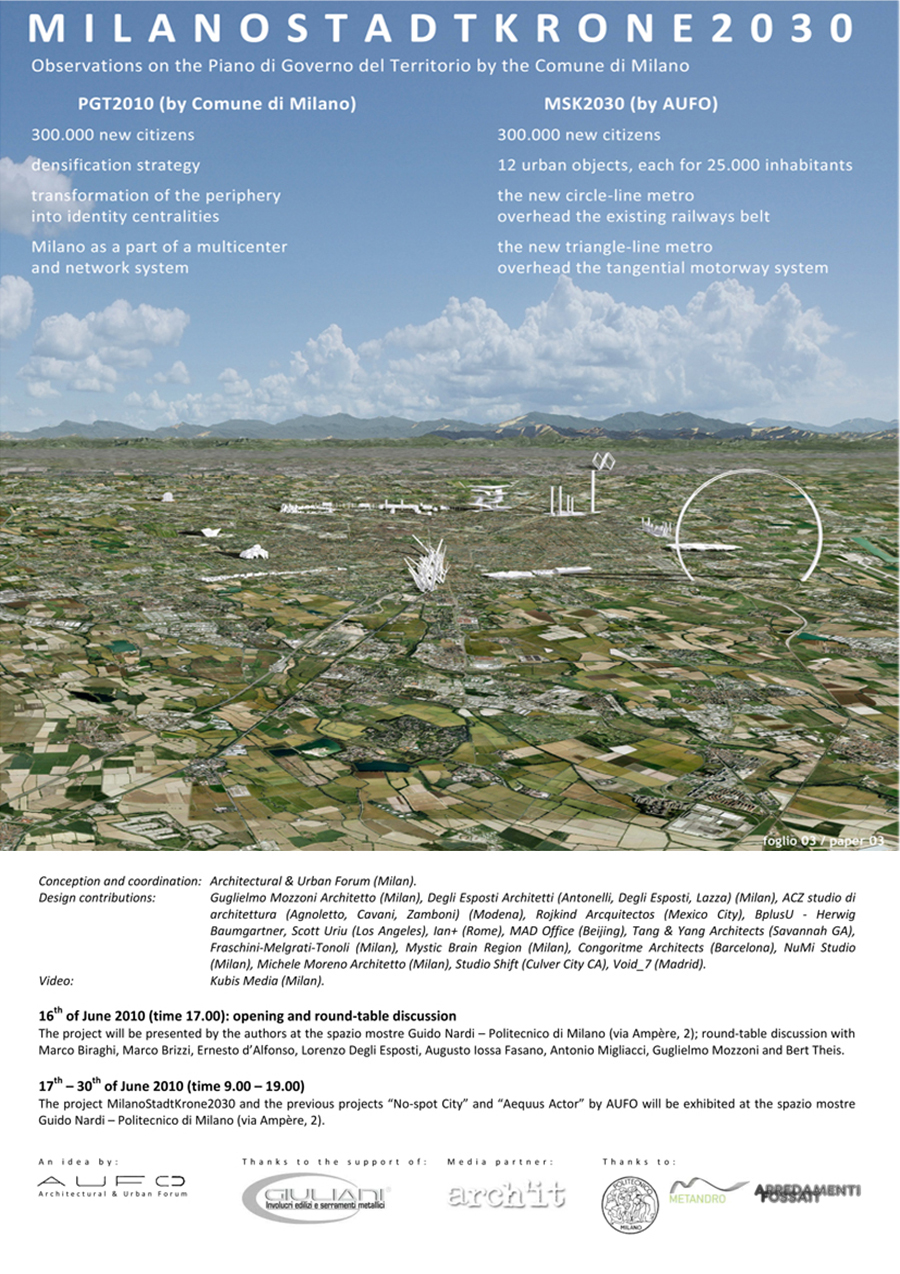Milano Stadtkrone 2030 Exhibition
Exhibition at the Politecnico di Milano
June 16th, 2010
Commissioned by the Architectural and Urban Forum (AUFO) of Milano with support from the Comune dil Milano, this is one of twelve proposals located on the periphery of the historic city center offering conceptual solutions for the densification of Milano. Each proposal injects 25,000 inhabitants into the existing fabric of Milano for a total population increase of 300,000. The exhibition opens June 16, 2010 at the Politecnico di Milano.
For this project the Architectural & Urban Forum (AUFO invited 15 international architects to design 15 urban- objects. The study participants are:
Architect William Mozzoni (Milan), Degli Esposti Architects (Antonelli, Degli Esposti, Lazza) (Milan), ACZ architectural firm (Agnoletto, Cavani, Zamboni) (Modena), Rojkind Arcquitectos (Ciudad de Mexico), BplusU (Herwig Baumgartner Scott Uriu) (Los Angeles), Ian + (Rome), MAD Office (Beijing), Tang & Yang Architects (Savannah GA) Fraschini-Melgrati-Tonoli (Milan), Mystic Brain Region (Milan), Congoritme Architects (Barcelona) Numi Studio (Milan), Michele Moreno Architect (Milan), Studio Shift (Culver City CA) Void_7 (Madrid).
“City Futura†is a visionary urban design proposal for an expansion of the City of Milan. B+U's site is located in the North-West part of the city close to Piazzale Giovanni dalle Bande Nere adjacent to the Bande Nere metro train station. City Futura is superimposed over the existing city leaving most of its buildings untouched and tapping into existing infrastructure and expand it.
Urban design concept- Tissue and Void
The 600m tall structure hovers over the city covering about a million square meter area and is divided into nine districts that are organized around three programmatic topics including: A- Civic; B- Entertainment and Recreation; and C-Art, Fashion and Manufacturing. Initially the nine districts were represented as spherical void spaces and randomly placed across the site, floating above the ground and varying in size and height they became placeholders for enormous civic arenas which expand up to 250 meters in diameter.
These public super centers act as a scaffold for developing a new kind of urban tissue that is not defined by conventional massing and zoning rules within a two dimensional city grid but are based on emergent growth models and developed by linking together families of massing elements that form larger subsystems in-between and around these public hubs, which then in turn are linked again to give rise to a grander systems vastly expanding across the city. Elevating this system off the ground exposes the underside of the city, a quasi sixth façade. It allowed us to rethink the city quite literally from the ground up envisioning how one might move through it and how infrastructure might develop, how our spatial perception and experience might change, how our organizational models can be expanded and new interrelations can be made. City Futura touches ground and connects with the “old†city at several strategically important locations, which are related to existing or newly proposed infrastructure, including train stations, metro lines and sky trains that connect the 70,000 plus inhabitants of this new part of town with the rest of Milan and the world. The Districts that can be best described as enormous public outdoor spaces, which expand vertically and horizontally approximating the spherical void, which based on its geometry is mostly covered, but has large openings bringing in daylight and expanding views to the city all around. Driving underneath one of these vibrant hubs will be an impressive experience and visually draw you up into these hyper-dense urban centers that appear to be floating hundreds of meters above you. One of the largest hubs is the Entertainment and Recreation district (represented on the close up rendering), that includes for example a 5,000 seat outdoor amphitheater for film, opera, dance and music; a playhouses, clubs, restaurants, movie theaters mixed in several vertical green spaces that in total exceed the size of Central Park in New York City. The building volumes connecting the districts with each other consist of an exuberant and highly differentiated massing morphology that provides around 6.5 million square meters of housing, offices and commercial spaces and is the core structure for this urban vision of Milan’s future.

